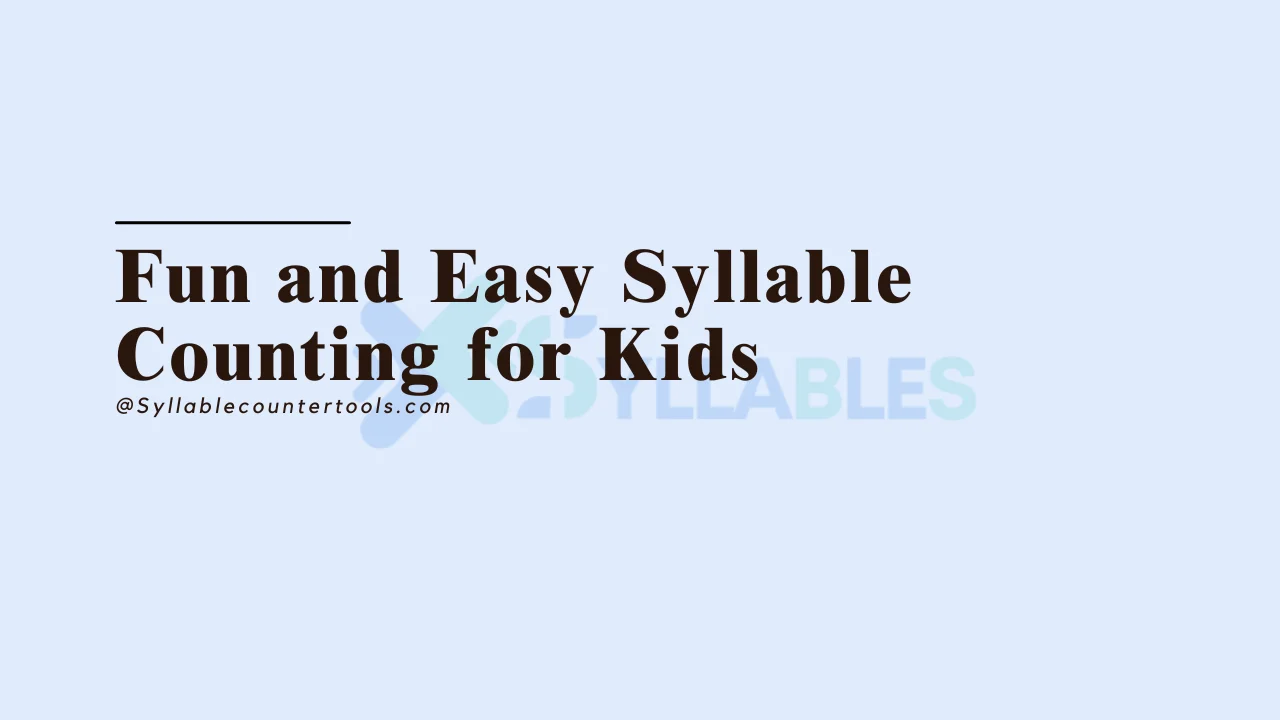2025’s Best Syllable Counting Tool for Kids – Easy Learning
What is syllable counting?
Syllable counting is breaking words into their smallest spoken units, called syllables. For example, the word “apple” has two syllables: apple. This skill supports early language development by aiding children in pronunciation and word recognition.
Why is it important for kids?
Understanding syllables builds strong foundations in reading, writing, and speaking. It enhances phonemic awareness, a critical skill for confident readers and effective communicators.
Why is syllable counting for kids essential for language development?
Syllable counting for kids strengthens phonemic awareness and supports language mastery. By breaking words into manageable sound units, it improves pronunciation, reading fluency, and writing skills.
The curiosity around words like “child” and its variable syllable count
Words like “child” intrigue learners because their syllable count may vary based on pronunciation or regional accents, adding an engaging aspect to language learning.
How to Teach Kids to Count Syllables?

Interactive Techniques:
- Clapping Method: Say a word and clap for each syllable. For example, clap three times for “banana” (ba-na-na).
- Tapping Method: Use fingers to tap out syllables. This tactile approach works well for kinesthetic learners.
- Chin Movement Method: Place a hand under the chin to count how many times it drops while saying a word.
Fun Activities:
- Syllable sorting games: Create a game where children sort words by syllable count, such as one-syllable words in one pile and two-syllable words in another.
- Rhyming words and syllable counting: Combine rhyming activities with syllable counting. Ask kids to find rhyming words and count their syllables.
- Counting syllables in everyday objects: Encourage children to find objects around the house or classroom and count the syllables in their names, turning learning into an exploratory activity.
Use of Tools and Resources:
- Flashcards with visual aids.
- Apps designed for phonemic awareness.
- Printable worksheets and online games focused on phonics practice.
What Is the Syllable Count for “Child”?
Syllable Count: “Child” is generally considered a one-syllable word. It contains a single vowel sound.
Why does “Child” Sometimes Become a Two-Syllable Word?
- Regional accents or speech patterns may introduce a slight “uh” sound after the “l,” making it sound like two syllables: chil-duh.
- Informal or exaggerated enunciation can also cause this variation.
When Can Kids Start Counting Syllables?
Age Range: Children typically begin syllable counting around 4–5 years old, though some preschoolers with strong phonemic awareness may start earlier.
Developmental Signs:
- Ability to recognize individual sounds in words.
- Understanding of basic speech rhythms.
What Are 5-Syllable Words for Kids?
Examples of 5-Syllable Words:
- Banana-rima
- Hippopotamus
- Mathematical
- Unbelievable
- Educational
Activities with 5-Syllable Words:
- Create rhymes using these words.
- Play a syllable hopscotch game to keep learning and engaging.
Tools and Resources

Apps for syllable counting: Interactive apps like ABCmouse and Phonics Hero offer engaging syllable counting games for kids.
Printable worksheets: Downloadable worksheets with matching and coloring activities reinforce syllable counting concepts.
Online videos: Platforms like YouTube provide educational videos that teach syllable counting in a fun and visual way.
Role of Parents and Teachers
Parental Involvement: Parents can include syllable counting for kids in daily activities, such as reading bedtime stories or cooking together.
Teacher Strategies: Teachers can integrate syllable counting into group activities, songs, and storytelling in the classroom.
Advanced Tips
Moving to multi-syllable words: Challenge children with longer words like “unbelievable” or “refrigerator” after they master simpler ones.
Incorporating syllable counting in daily life: Encourage children to count syllables in street names, grocery items, or friends’ names for practical application.
Importance of Consistency
Practice makes perfect: Regular practice builds confidence in syllable checking, and repetition ensures mastery over time.
Tracking progress: Use journals or charts to track progress. Celebrate milestones to keep kids motivated and engaged.
Fun Facts about Syllables
- The word “syllable” has three syllables.
- Japanese haikus rely on syllable counts (5-7-5).
- Some languages, like Hawaiian, have simpler syllable structures than English.
Related Articles:
Free Online Syllable Counter for Writers
Syllable Counter For Haiku Writing
Syllable Counter for Poems: How to Check Syllables in Poems
Conclusion
Syllable counting for kids is a foundational skill for language development. Engaging activities, accessible resources, and consistent practice make learning enjoyable for kids. Start clapping, tapping, and counting syllables today!
Author: Raja Muhammad Ali







